ASRock Rack C2750D4I Review: A Storage Motherboard with Management
by Ian Cutress on April 29, 2014 9:00 AM EST- Posted in
- Motherboards
- Storage
- Atom
- ASRock
- Silvermont
- Enterprise
- server
- Avoton
ASRock C2750D4I In The Box
Server motherboard packages are almost confusing. On the one hand it is a premium product that should get premium treatment, especially if it is end-user facing rather than server customer facing. The counter argument to this comes from server motherboard users knowing exactly what they want to use, so why waste money adding equipment that might not be applicable? The variation of cases or server chassis mean it is almost pointless to add something like a USB bay or rear bracket.
Nevertheless ASRock offers the following with the C2750D4I:
Driver DVD
Manual
Rear IO Shield
Four SATA Cables
Being a motherboard aimed at storage we should be glad that at least some cables are there, but this is only 1/3 of the number of SATA ports on the motherboard. In a server case I would imagine that all the cables are of appropriate length, and that can be hard to judge – so some is better than none but not as useless as more. If that makes any sense.
Many thanks to...
We must thank the following companies for kindly providing hardware for our test bed:
Thank you to OCZ for providing us with 1250W Gold Power Supplies and SSDs.
Thank you to ADATA for providing us with memory.
Thank you to ASUS for providing us with the AMD HD7970 GPUs and some IO Testing kit.
Thank you to MSI for providing us with the NVIDIA GTX 770 Lightning GPUs.
Also thank you to Silverstone for sending us the DS380 case.
Test Setup
| Test Setup | |
| Processor |
Intel Avoton C2750 8 Cores, 2.4 GHz (2.6 GHz Turbo) |
| Motherboards | ASRock C2750D4I |
| Cooling | Basic 8cm Fan |
| Power Supply |
OCZ 1250W Gold ZX Series Silverstone 300W SFX PSU |
| Memory | ADATA XPG V1.0 2x8GB DDR3L-1600 9-11-9 1.35V Kit |
| Memory Settings | XMP |
| Video Cards |
MSI GTX 770 Lightning 2GB (1150/1202 Boost) ASUS HD7970 3GB (Reference) |
| Video Drivers |
AMD Catalyst 13.12 WHQL NVIDIA Drivers 332.21 WHQL |
| Hard Drive | OCZ Vertex 3 256GB |
| Optical Drive | LG GH22NS50 |
| Case | Silverstone DS380 |
| Operating System | Windows 7 64-bit SP1 |
| USB 2/3 Testing | OCZ Vertex 3 240GB with SATA->USB Adaptor |
Power Consumption
Power consumption was tested on the system as a whole with a wall meter connected to the OCZ 1250W power supply, while in a single MSI GTX 770 Lightning GPU configuration. This power supply is Gold rated, and as I am in the UK on a 230-240 V supply, leads to ~75% efficiency > 50W, and 90%+ efficiency at 250W, which is suitable for both idle and multi-GPU loading. This method of power reading allows us to compare the power management of the UEFI and the board to supply components with power under load, and includes typical PSU losses due to efficiency. These are the real world values that consumers may expect from a typical system (minus the monitor) using this motherboard.
While this method for power measurement may not be ideal, and you feel these numbers are not representative due to the high wattage power supply being used (we use the same PSU to remain consistent over a series of reviews, and the fact that some boards on our test bed get tested with three or four high powered GPUs), the important point to take away is the relationship between the numbers. These boards are all under the same conditions, and thus the differences between them should be easy to spot.
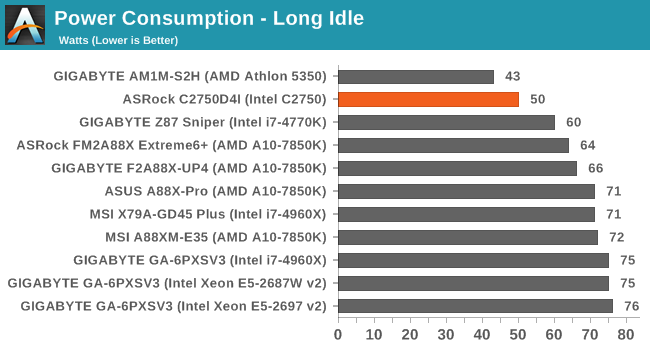
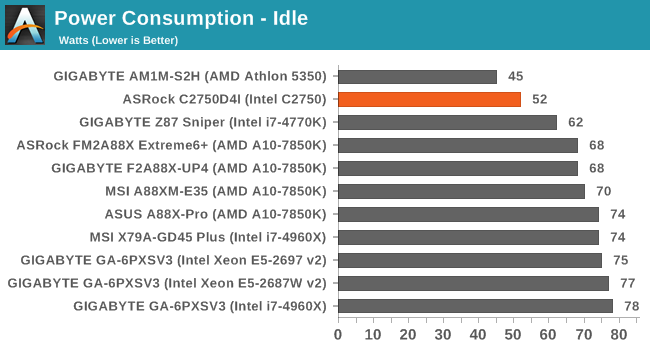
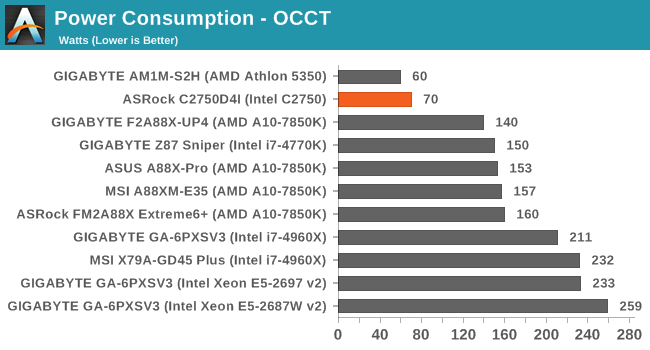
We added in the results from our 25W Kabini platform we are currently testing for a future review, just to show how much difference having the extra controllers and the remote management effects our idle and power loadings. It would therefore reveal that the extra featureset on the C2750D4I equates to 7-10W on our test bed.
Windows 7 POST Time
Different motherboards have different POST sequences before an operating system is initialized. A lot of this is dependent on the board itself, and POST boot time is determined by the controllers on board (and the sequence of how those extras are organized). As part of our testing, we are now going to look at the POST Boot Time - this is the time from pressing the ON button on the computer to when Windows 7 starts loading. (We discount Windows loading as it is highly variable given Windows specific features.) These results are subject to human error, so please allow +/- 1 second in these results.
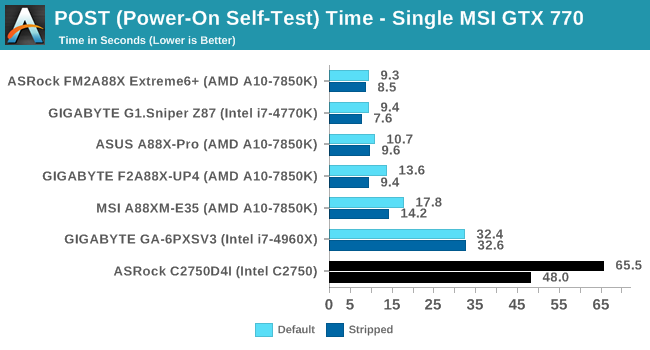
The issue with remote management systems is always the pre-initialisation time, which on the C2750D4I is unforgiving. However, it is often not a focus of a system such as this which might remain in constant operation for several years without a restart.


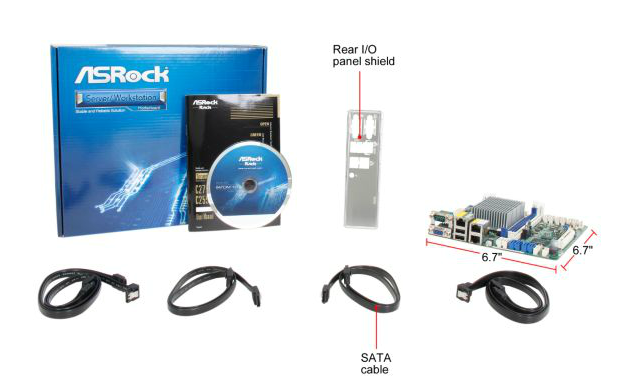








85 Comments
View All Comments
Marquis - Tuesday, April 29, 2014 - link
Nevermind, reading comprehension FTW. The other two are mentioned later....bombshelter - Tuesday, April 29, 2014 - link
Your comment about the reason for using the PLX switch is wrong. First, the PEX8608 is an 8-lane switch and they are using it in a x4 (from CPU) to 4 x1s (to PCIe end-points) topology. The Avoton CPU actually has a total of 16 PCIe lanes, but can only bifurcate to 4 controllers. So the real reason they are using the PLX switch is to be able to have more than 4 PCIe end-points connected to the CPU. There will be no performance degradation or sharing of bandwidth due to the presence of the PLX switch since there is an equal number of lanes going into it from the CPU as as there are end-points connected on the downstream side.Ian Cutress - Tuesday, April 29, 2014 - link
Aha, yes my interpretation of the chipset diagram was a little off. Going to update the review.chang3d - Tuesday, April 29, 2014 - link
Supermicro has two similar board with a few differences of SO-DIMM, USB 3, 4 NICs, and 6 sata headers. It's also cheaper. I think the features of this board is much better than this ASRock board.http://www.newegg.com/Product/Product.aspx?Item=N8...
ddriver - Tuesday, April 29, 2014 - link
Is it just me or was this review an extremely bad match to that product? What about NAS performance, which undoubtedly will be one of the major selling points? Instead we get gaming on a product as far from gaming as it gets. And content creation?Ian Cutress - Tuesday, April 29, 2014 - link
According to users on several forums, this board has been the focus of many different types of build. I've done a brief analysis here of usability and interface, but Ganesh is our storage guru and has all the equipment for storage related tests, so I'd rather leave that in his court for a follow-up review rather than fumble through them myself.ddriver - Wednesday, April 30, 2014 - link
No offense, but you have reviewed a rake as a back scratcher :)With such massive storage capacity, dual gigabit onboard, up to 64 GB of ECC ram - computational performance is irrelevant, this product is all about throughput. While it may be viewed as somewhat beneficial to get concrete numbers, yet after all the numbers only confirm this product ain't neither about gaming nor about content creation, so if anything the review is useful at proving its uselessness, which makes it technically useful - which is quite a nice paradox ;)
LastQuark - Monday, May 5, 2014 - link
It's not you. This is perfect to me for what this board is intended for - virtualization, NAS, home web server, backup, even good enough for a Plex or XMBC server. The review made it seem like it is for HTPC and gaming which it is not.DuckieHo - Tuesday, April 29, 2014 - link
Drop the AST2300 for management.Drop BMC/SMB.
Drop IPMB.
Drop TPM.
Drop COM port.
Reduce fan ports (6 PWM to 4 PWM).
Drop a SATA controller (12 ports to 8 or 10).
Increase the size of the heatsink and/or add a fan.
Drop the price in half for a consumer version please!
Rick83 - Tuesday, April 29, 2014 - link
There's a quad-core version of the same board at 3/4 the price. That should be enough for most home users. It's also a 14W part, so has less cooling needs.